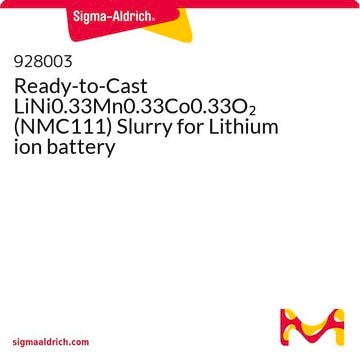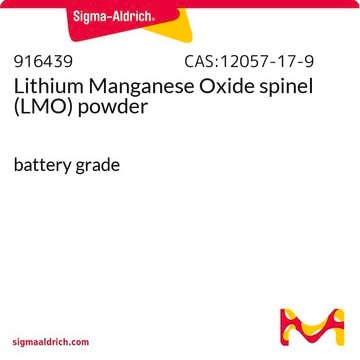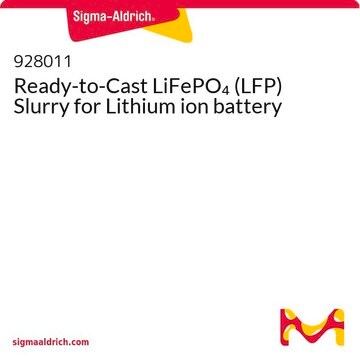765171
Lithium nickel cobalt aluminium oxide
electrode sheet, aluminum substrate, size 5 in. × 10 in.
Synonym(e):
NCA
About This Item
Empfohlene Produkte
Qualität
battery grade
Beschreibung
Nominal Voltage: 3.7 V, Li/Li+
Assay
≥98%
Zusammensetzung
loading, ≥80%
Grünere Alternativprodukt-Eigenschaften
Design for Energy Efficiency
Learn more about the Principles of Green Chemistry.
sustainability
Greener Alternative Product
Kennzeichnungsgrad
≥80% loading
Größe
5 in. × 10 in.
Dicke
12-25 μm
Partikelgröße
10-13 μm (typical)
Kapazität
150 mAh/g(minimum)
180 mAh/g(nominal at 0.1C)
mp (Schmelzpunkt)
>1000 °C
Anwendung(en)
battery manufacturing
Grünere Alternativprodukt-Kategorie
, Enabling
Allgemeine Beschreibung
Anwendung
The NCA casted electrode sheets can be cut into appropriate size and is ready to be used in lithium ion batteries.
Sonstige Hinweise
Operating Condiditons:
- Recommended maximum charge voltage: 4.3 V vs Li/Li+
- Recommended maximum charge current: 4C
- Recommended cut-off voltage for discharge: 3.0 V vs Li/Li+
- Recommended charge method: constant current - constant voltage
Signalwort
Warning
H-Sätze
Gefahreneinstufungen
Carc. 2 - Skin Sens. 1
Lagerklassenschlüssel
11 - Combustible Solids
WGK
WGK 3
Flammpunkt (°F)
Not applicable
Flammpunkt (°C)
Not applicable
Analysenzertifikate (COA)
Suchen Sie nach Analysenzertifikate (COA), indem Sie die Lot-/Chargennummer des Produkts eingeben. Lot- und Chargennummern sind auf dem Produktetikett hinter den Wörtern ‘Lot’ oder ‘Batch’ (Lot oder Charge) zu finden.
Besitzen Sie dieses Produkt bereits?
In der Dokumentenbibliothek finden Sie die Dokumentation zu den Produkten, die Sie kürzlich erworben haben.
Kunden haben sich ebenfalls angesehen
Artikel
Professor Qiao's review explores stable microstructures for lithium metal fluoride batteries, advancing energy storage technologies.
Solid oxide fuel cells and electrolyzers show potential for chemical-to-electrical energy conversion, despite early development stages.
Li-ion batteries are currently the focus of numerous research efforts with applications designed to reduce carbon-based emissions and improve energy storage capabilities.
Lithium-ion batteries offer high energy density and cyclic performance for portable electronic devices.
Unser Team von Wissenschaftlern verfügt über Erfahrung in allen Forschungsbereichen einschließlich Life Science, Materialwissenschaften, chemischer Synthese, Chromatographie, Analytik und vielen mehr..
Setzen Sie sich mit dem technischen Dienst in Verbindung.















